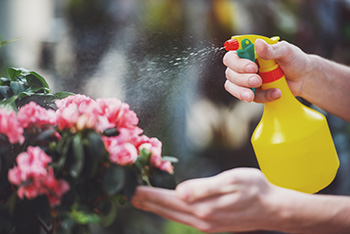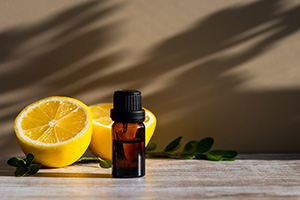Natural Pest and Disease Management

Natural products for pest control can be better for the environment, people and pet safety, and organic gardening. They are used alone or in combination with synthetic products to prevent pesticide resistance. An integrated pest management program (IPM) is always encouraged to achieve best results.
General Considerations
Before we get into details, there are some pros and cons associated with natural pesticides to keep in mind:
Pros
- Quicker breakdown — Natural pesticides do not persist in the environment long after application, which reduces risk of harming nontarget organisms. However, this means repeat applications may be necessary.
- Fast action — Some kill insects upon contact, and others stop insects from feeding upon ingestion.
- Low toxicity — Most products have low to moderate toxicity to mammals, although they should still be handled with caution as with all pesticides.
Cons
- Phytotoxicity — Labels must be read carefully to avoid damage to plants, especially if they are already stressed.
- Cost and availability — Natural products can be more expensive and harder to find than their synthetic counterparts. Potency can also vary by source.
- State registration — Not all products listed for sale online are registered for legal sale in Florida. You can search the National Pesticide Information Retrieval System to check: https://www.npirs.org/state/.
- Lack of EPA review — Some products are exempt from EPA review, which means there is not always data on topics such as safety and effectiveness.
Oils

Oils are best for targeting small, soft-bodies insects that are slow moving such as aphids, scales, leafhopper nymphs, and whiteflies. The oil should be sprayed directly on the pest or eggs to kill them. There is no residual effect, so the oil must be reapplied when new pests appear.
- Citrus oils — There are two compounds found in citrus that are used as pesticides: limonene and linalool. Citrus oils are used to kill fleas, aphids, mites, fire ants, several flies, paper wasps, and house crickets on contact. These are low in toxicity and are generally safe for mammals. In fact, you can even find them in shampoos and dips for pets. Use with caution on new or sensitive plants.
- Neem — Neem oil comes from the seeds of the neem tree (Azadirachta indica), which is native to India. It kills soft-bodied pests such as whiteflies and mealybug and scale nymphs by thorough contact. Some products can also prevent plant diseases. Azadirachtin is the main insecticide in neem oil, and it can be purchased in a concentrated form to combat caterpillars, sawflies, flea beetles, weevils, aphids, and leafhoppers. This product targets the immature stages of chewing pests. It has some systemic activity in roots and leaves which controls leafminers. Neem products can vary in potency, so try a different one if it doesn’t work at first. Just be sure to stay away from neem oil products being sold as cosmetics or medicinal essential oils.
- Essential oils — These are typically a combination of various plant oils, plant oils with plant extracts, or plant oils with fish oil. These can potentially affect larger insects, although effectiveness is not consistent. A trial-and-error approach is best. Common oil components are sesame, garlic, canola, and soybean. Herbal extracts include thyme, rosemary, peppermint, cinnamon, and clove. These are considered a low risk to humans and pests when applied appropriately, except for pennyroyal which is toxic if ingested.
- Horticultural oils — These oils are derived from petroleum, and are also called hort oils, spray oils, or summer/dormant oils. They are mixed with water and sprayed thoroughly onto foliage and bark to manage piercing-sucking insects, mites, and other small, soft-bodied insects. Use a lower concentration if plants are actively growing or blooming and do not apply if the temperature is above 90 degrees Fahrenheit. They have very low toxicity and no residual effect when applied according to the label.
Insecticidal Soaps

Insecticidal soaps combat soft-bodied pests such as aphids, soft scales, psyllids, whiteflies, mealybugs, thrips, and spider mites through direct contact. There is no residual effect after application. Check the label before applying because some plants are too sensitive for it. You can also do a test application on a small area of a plant and check for signs of burning after a day. Note: household soaps should never be used as a pesticide because they are often not as effective and are more likely to burn your plants.
Plant Extracts
- Pyrethrum/Pyrethrins — Pyrethrins are concentrated compounds from a daisy-like Kenyan flower (Chrysanthemum cinerariaafolium). The powdered form is called pyrethrum. These are used for ants, roaches, fleas, flies, ticks, and garden pests. They are available in several forms including mixed with other products or conventional pesticides. Some insects can recover from pyrethrins alone, so many products are mixed with a substance that increases its effectiveness such as piperonyl butoxide (PBO) or MGK 264. Pyrethrins are often selected because they have repellent properties, short residual activity, and low mammalian toxicity. However, some people have allergic skin reactions, and it is poisonous to cats and fish.
- Hot pepper — Capsaicinoids, the component in peppers that makes peppers spicy, is mixed with paraffin and sold as a repellant for insects and animals. The effectiveness of this extract is debated.
- Rotenone, Ryania, Sabadilla, and Nicotine — These are no longer recommended for use in Florida due to toxicity and registration issues.
Mineral Insecticides
- Diatomaceous earth — This product is made from fossilized silica shell remains of single-celled aquatic algae. It causes bugs such as ants, fleas, bed, bugs, and cockroaches to fatally dehydrate. Diatomaceous earth is not recommended for use outdoors in humid Florida because it must stay dry to work properly.
- Kaolin clay — This clay mineral is finely ground and mixed with water to create a spray. Applying the spray to leaves, stems, and fruit leaves a white film that protects the plant from insect damage and sun scorch. It is not toxic for humans, but it may also deter beneficial insects. Reapplication is necessary after heavy rains.
- Sulfur — This product comes in dust, fumigant, wettable powder, paste, or liquid forms. It combats mites, psyllids, and thrips. Unfortunately, it also harms beneficial predatory mites and parasitoids. Plant damage can be caused by applying sulfur to the wrong plants, in hot, dry weather, or within two to three weeks of a prior treatment. It is not toxic to mammals but can irritate skin or eyes. Carefully follow label instructions to avoid these issues.
- Iron phosphate — Iron phosphate is marketed as a safer alternative to metaldehyde for baiting slugs and snails. For best results, sprinkle the bait granules in the late afternoon or evening right after irrigating. Don’t water afterwards to avoid dissolving the bait.

Microbial Insecticides
Microbial insecticides are a type of biopesticide that includes microorganisms such as viruses, bacteria, fungi, protozoa, or nematodes. Microbial insecticides have a reduced risk of harming nontarget insects, are not pathogenic to humans, pets, or wildlife, and can be used alongside conventional insecticides. Products vary greatly in application and ideal conditions, so be sure to read the entire label before using.
- Bacillus thuringiensis (Bt) — Bacillus thuringiensis (Bt) is the most-used microbial insecticide because it is effective, inexpensive, and low risk to beneficial insects. It is naturally found in soil, freshwater, and on plant surfaces. There are various products available that each target a specific pest at a certain stage of its life cycle. Bt is rapidly broken down by sunlight, so repeat applications may be required to eradicate pests.
- Spinosad — Spinosad is also derived from soil bacteria, and it is a broad-spectrum control method for insects including caterpillars, leaf miners, flies, thrips, beetles, and spider mites. It has low to moderate toxicity to beneficial insects and nearly no toxicity to mammals and other wildlife. It can kill bees when wet, so only apply it during the early morning, late evening, or at night when bees are not out.
- Chromobacterium subtsugae — This product works against a wide range of insects and mites, although UF/IFAS trials have discovered that it works particularly well against foliar-feeding beetles. Beneficial insects are unlikely to be harmed, but label instructions should be carefully followed to prevent harming bees, aquatic invertebrates, and soil organisms.
- Burkholderia — There are several products made from different strains of this bacteria to control pests such as caterpillars, aphids, stink bugs, thrips, spider mites, and nematodes.
- Fungi — There are quite a few insect-parasitic fungi on the market, but Beauveria bassiana is one of the few available to gardeners. These products work against foliar-feeding pests like aphids, thrips, whiteflies, beetles, and spider mites. Death can take a few days, but spores will be emitted from dead insects to help control subsequent generations.
- Insect-parasitic nematodes — The two most commonly available beneficial nematodes are Steinernema and Heterorhabditis. They kill soil-dwelling insect hosts by entering their bodies and releasing toxic bacteria into their blood. They thrive in sheltered or undisturbed, moist environments. Different species of nematodes have different host preferences, so make sure to select the correct one for your pest problem.
- Viruses Several insect viruses have been developed, but they are not readily available, are expensive, and most are not registered for use in Florida.

Natural Products for Disease Management
The best way to prevent disease is to follow the “right plant, right place” rule. Healthy plants are the best defense against disease. The following natural products are intended to help defend plants from disease, although they will be ineffective once a plant is infected. Make sure to remove infected plants or plant parts before application.
- Biofungicides — Several microorganisms are used to prevent fungal and bacterial diseases, although the most common is Bacillus subtilis. Generally, these products work by outcompeting pathogens or by producing an inhibitive substance. They must colonize the plant’s roots or foliage before infection to be effective.
- Copper — Copper acts as a protective barrier against pathogens when sprayed on plant surfaces. There are many different formulations with unique properties (including toxicities), so carefully read label instructions. Apply copper products at a time when they can dry quickly to minimize plant injury. As a bonus, the residues can also deter slug and snail feeding.
- Potassium bicarbonate and sodium bicarbonate — These two products offer some protection when used preventatively, but they do not offer a high level of disease control. The main benefit is that they low in toxicity to the environment and mammals. Potassium bicarbonate works better than sodium bicarbonate (baking soda) and it is less likely to harm plants. Baking soda can damage leaves if applied in too high of a concentration or if excessive buildup occurs. Either option requires reapplication after rainfall.
- Sulfur — Sulfur prevents spore germination, and is an effective fungicide against powdery mildew, rusts, leaf blights, fruit rots, and other plant diseases.

For more information about natural pest and disease management, contact the experts at your county Extension office.
